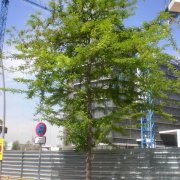Care of the tree Gleditsia triacanthos or Honey locust |
|
The genus Gleditsia, family Fabaceae, comprises 10 species of trees native to Africa, North America and the Far East. Some species are: Gleditsia triacanthos, Gleditsia sinensis, Gleditsia aquatica, Gleditsia macracantha. Common names: Thorny locust, Honey locust. This species is native to central North America. They are deciduous trees with a wide crown that reach 20 meters (65.6 feet) in height. They have long spines and paripinnate leaves. They produce clusters of small yellow flowers. They bloom in early summer. The fruits appear in the form of long pods. Honey locust is used as isolated specimens, in streets and public parks and to form hedges. Gleditsia triacanthos needs full sun exposure and warm temperatures. It resists occasional frosts. The ideal soil must contain organic matter, be well drained and have the capacity to retain water; it can grow in dry and limestone soils. Planting is done in winter or autumn. Water moderately, waiting for the substrate to dry; Gleditsia triacanthos is a drought resistant tree. Fertilize with manure in the fall. Thorny locust can be pruned in late summer to keep them compact. Gleditsia triacanthos is a fast growing tree and quite resistant to pests and diseases. Honey locust propagates by seeds but it's not a simple process; it's advisable to buy new specimens in nurseries and garden centers. |
Images of the tree Gleditsia triacanthos or Honey locust |
Find plants
Gleditsia triacanthos or Honey locust | Care and Growing
© 2025 FavThemes


